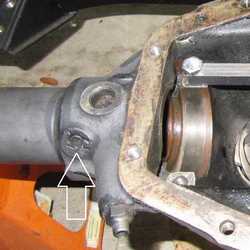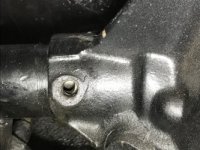Offline
One of the axle tubes on my rear axle became slightly loose, allowing maybe 25 mils of movement at the outer end. I noticed that one of the pins in the differential housing that apparently hold the tube in place became loose.
There are four of these on each end. The picture below shows one of them. It's that staked thingy between the opening and the tube.

I always assumed that these were 3/8-inch screws that were tightened down, cut off, and staked, but the loose one rotated freely in the hole, without moving in or out, so obviously it was not a screw. But if it's just a pin that is inserted, perhaps with a little force, and just staked, I can't see how it would be strong enough to support the forces on the tube, which are substantial.
Does anyone know precisely how this joint is put together? Is there more than it appears?
I see this kind of construction on other differentials, so it must be strong enough, but I really can't see why.
There are four of these on each end. The picture below shows one of them. It's that staked thingy between the opening and the tube.

I always assumed that these were 3/8-inch screws that were tightened down, cut off, and staked, but the loose one rotated freely in the hole, without moving in or out, so obviously it was not a screw. But if it's just a pin that is inserted, perhaps with a little force, and just staked, I can't see how it would be strong enough to support the forces on the tube, which are substantial.
Does anyone know precisely how this joint is put together? Is there more than it appears?
I see this kind of construction on other differentials, so it must be strong enough, but I really can't see why.

 Hi Guest!
Hi Guest!

 smilie in place of the real @
smilie in place of the real @
 Pretty Please - add it to our Events forum(s) and add to the calendar! >>
Pretty Please - add it to our Events forum(s) and add to the calendar! >> 

